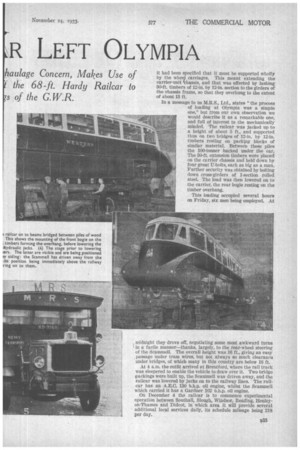How THE RAILC
Page 42

Page 43

If you've noticed an error in this article please click here to report it so we can fix it.
R LEFT OLYMPIA
pICTURES reproduced on these pages tell, perhaps better than words are able to explain, the nature of the task of transporting the big Hardy oilengined railcar—one of the outstanding exhibits at the recent Commercial Motor Show—to and from Olympia, London.
So many visitors to the exhibition inquired as to how so large and heavy a vehicle could be brought by road into the hall and taken away again that we have decided to give our readers a brief account of the Job. We cannot, of course, say how much it cost, but the task was 'undertaken lightly, as one of the many interesting vehicle manoeuvres which have to be effected to present the fine display that one sees at Olympia.
We will explain in particular the removal of the railcar from Olympia to the G.W.R. sidings at Brentford, which took place last Friday and Saturday. M.R.S., Ltd., the famous heavy-haulage concern of London and Liverpool, brought its Scammell articulated 100tonner from the north of England, all arrangements having been made in advance of the date axed for the job.
It must be understood that with an overall length. for the loaded vehicle, of 104 ft., it is difficult to effect manoeuvres without fouling pillar-boxes, railings, gate-posts, lamp-posts, refuges, etc., so that a surveyor had to cover the whole route in advance, making meticulous measurements at every corner.
From the point of view of weight the railcar presented little difficulty. for it turns the scale at only about 20 tons. Its dimensions, however, especially its 68-IL length, raised a considerable problem in that the carrier portion of the Scammell vehicle—the largest of its kind in the world—is 43 ft. long. The overall length of the Scammell is 76 ft., and for this job its rearmost line of four double-tyred wheels (forming half of the bogie) was detached. The railcar is 8 ft. 6 ins, wide and 12 ft. high and its wheelbase is 40 ft.
It is obvious that the railcar could not rest with all wheels on the chassis of the vehicle, and to obviate risk of distortion B32
It had been specified that it must be supported wholly by the whee,1 carriages. This meant extending the carrier-unit thassis, and that was effected by lashing 30-ft. timbers of 12-in.. by 12-in. section to the girders of the chassis frame, so that they overhung to the extent of about 13 ft.
In a message to us 11.R.S., Ltd., states "the process of loading at Olympia was a simple one," but from our own observation we would describe it as a remarkable one, and full of interest to the mechanically minded. The railcar was jacked up to a height of about 5 ft., and supported thus on two bridges of 12-in. by 12-in. timbers resting on packing blocks of similar material. Between these piles the 100-toruner backed under the car. The 30-ft. extension timbers were placed on the carrier chassis and held down by four great U-bolts, each as big as a man. Further security was obtained by bolting down cross-girders of I-section rolled steel. The load was then lowered on to the carrier, the rear bogie resting on the timber overhang.
This loading occupied several hours on Friday, six men being employed. At midnight they drove off, negotiating some most awkward turns I in a facile manner—thanks, largely, to the rear-wheel steering of the Scammell. The overall height was 16 ft., giving an easy passage under tram wires, but not always so much clearance under bridges, of which many in this country are below 16 ft. At 4 a.m. the outfit arrived at Brentford, where the rail track was sleepered to enable the vehicle to draw over it. Two bridge packings were built up, the Searamell was driven away, and the railcar was lowered by jacks on to the railway lines. The railcar has an A.E.C. 130 b.h.p. oil engine, whilst the Scammell which carried it has a Gardner 102 b.h.p. oil engine.
On December 4 the railcar is to commence experimental operation between Southall, Slough, Windsor, Reading, Henleyon-Thames and Didcot, In which area it will provide several additional local services daily, its schedule mileage being 218 per day.




















































































